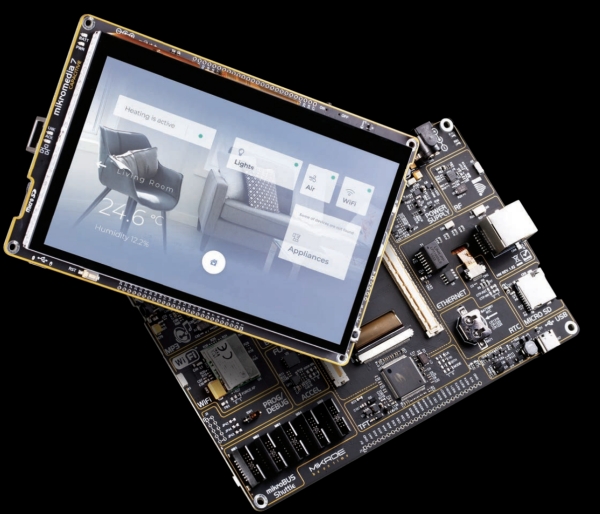Building beautiful GUI Based applications is the dream for every project which involves a display, however, quality of available displays and ease of development has always been a challenge. This is however fast-changing courtesy of the Mikromedia 7 Capacitive development board from Mikroe.

The mikromedia 7 Capacitive is a compact development board, designed as a complete solution for the rapid development of multimedia and GUI-centric applications. It features; a large 7” capacitive touch screen driven by a powerful graphics controller that can display a true-color 24-bit color palette (16.7 million colors), DSP-powered embedded sound CODEC IC, an MCU Card socket, a set of five compact mikroBUS™ Shuttle connectors, a set of very useful general-purpose sensors and devices, and more, essentially comprising of everything you need for the rapid development of different types of GUI-based applications.
At its core, there is an MCU Card socket (labeled 3 below) which allows Mikromedia 7 Capacitive to use any of the ARM® Cortex-M® microcontrollers (MCUs) mounted on a standardized MCU Card, regardless of their vendor or pin count. As a result of this, the Mikromedia 7 Capacitive is able to work with over 35o different MCUs. This provides a tremendous amount of flexibility, allowing mikromedia 7 to adapt to any specific application requirements, be it a demanding task of displaying fluid and glitch-free multimedia content, or something much simpler.
As a development board, the Mikromedia 7 features many connectivity options, including USB, Ethernet, nRF, WiFi, CAN (on the MCU Card that supports it) and two 1×26-pin headers. However, five compact-sized mikroBUS Shuttle connectors represent the most distinctive connectivity feature, allowing access to a huge base of Click boards™, growing on a daily basis. Each section of Mikromedia 7 is clearly marked, offering an intuitive and clean interface. Each section contains a single feature (WiFi, nRF, MP3, etc) along with the accompanying components and configuration jumpers. This makes working with the development board much simpler and thus, faster.
Read more: MIKROMEDIA 7 CAPACITIVE DISPLAY
